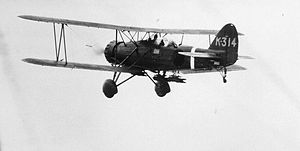Yokosuka B4Y
| B4Y1 | |
|---|---|
 | |
| General information | |
| Type | Torpedo bomber |
| Manufacturer | Yokosuka |
| Number built | 205 |
| History | |
| Introduction date | 1936 |
| First flight | 1935 |
| Retired | 1943 |
The Yokosuka B4Y (Navy Type 96 Carrier Attack Bomber) was a carrier-borne torpedo bomber used by the Imperial Japanese Navy Air Service from 1936 to 1943. The B4Y replaced the Mitsubishi B2M2 and the Yokosuka B3Y, and was the last biplane bomber used operationally by the Imperial Japanese Navy. The Allied reporting name was "Jean". This aircraft was mistakenly identified by the British as the Nakajima Navy G-96.[1]
Design and development
[edit]In 1932, the Imperial Japanese Navy issued a requirement for a new carrier-borne attack aircraft. Aichi, Mitsubishi and Nakajima responded to this requirement and each built a prototype. None of these aircraft were deemed satisfactory, and the service thus issued in 1934 a new requirement, 9-Shi, for a more capable aircraft to replace the obsolescent Yokosuka B3Y.

The B4Y was designed by Sanae Kawasaki at the First Naval Air Technical Arsenal at Yokosuka. Regarded only as an interim type, the Navy wanted a torpedo bomber offering performance comparable to the Mitsubishi A5M monoplane fighter. The result was a biplane with fixed landing gear and an all-metal structure with metal or fabric skin. To speed development and production, the B4Y utilised the wings from the Kawanishi E7K. The B4Y1 was also the first Navy carrier attack aircraft to utilize an air-cooled engine, as the prototype that was equipped with the Nakajima Hikari 2 radial engine performed better than its competitors.[2]
The crew of three occupied two cockpits. The pilot in the open front cockpit and the other two crewmen, (navigator and radio operator/gunner), in the enclosed rear cockpit.
Operational service
[edit]
On 12 December 1937 3 B4Y1s were involved in the Panay incident during a Japanese attack on the United States Navy gunboat Panay while she was anchored in the Yangtze River outside of Nanjing.
Although primarily used as a carrier-based aircraft, the B4Y1 was also used as a land-based bomber on occasion. In 1940, the Nakajima B5N replaced the B4Y1 as the primary carrier attack aircraft, though the B4Y1 did remain in service as an advanced trainer, and flew from Hōshō and Unyō until 1943.
Before its replacement, the B4Y1 had flown during the Second Sino-Japanese War and served at the Battle of Midway during June 1942, where eight of them were operated from Hōshō.[3] It was one of these planes from Hōshō which took photographs of the burning Hiryū on 5 June 1942.[4]
Variants
[edit]- First prototype
- 559 kW (750 hp) Hiro Type 91 520 hp water-cooled W-12 driving a two-bladed propeller.
- Second and third prototypes
- 477 kW (640 hp) Nakajima Kotobuki 3 nine-cylinder air-cooled radial driving a two-bladed propeller.
- Fourth and fifth prototype and production aircraft
- 636 kW (853 hp) Nakajima Hikari 2 nine-cylinder air-cooled radial driving a two-bladed propeller.
Production
[edit]- First Naval Air Technical Arsenal, Yokosuka: 5 prototypes (1935–36)
- Nakajima Aircraft Company: 37 production aircraft (1937–38)
- Mitsubishi Heavy Industries, Nagoya: 135 production aircraft (1937–38)
- 11th Naval Air Arsenal, Hiro: 28 production aircraft (1938)
- Total: 205 aircraft [5]
Operators
[edit]The B4Y1 was operated from the aircraft carriers Akagi, Hōshō, Kaga, Ryūjō, Sōryū, and Unyō, as well as the 13th and 15th Kōkūtai (Air Groups).[5]
Specifications (B4Y1)
[edit]Data from Japanese Aircraft of the Pacific War [5]
General characteristics
- Crew: 3 (pilot, navigator, radio operator/gunner)
- Length: 10.15 m (33 ft 4 in)
- Wingspan: 15 m (49 ft 3 in)
- Height: 4.36 m (14 ft 4 in)
- Wing area: 50 m2 (540 sq ft)
- Empty weight: 2,000 kg (4,409 lb)
- Gross weight: 3,600 kg (7,937 lb)
- Powerplant: 1 × Nakajima Hikari 2 9-cylinder air-cooled radial piston engine, 630 kW (840 hp) for take-off
- 522 kW (700 hp) at 1,200 m (3,900 ft)
- Propellers: 2-bladed fixed-pitch propeller
Performance
- Maximum speed: 278 km/h (173 mph, 150 kn)
- Range: 1,573 km (977 mi, 849 nmi)
- Service ceiling: 6,000 m (20,000 ft)
- Time to altitude: 3,000 m (9,800 ft)
- Wing loading: 72 kg/m2 (15 lb/sq ft)
- Power/mass: 0.1749 kW/kg (0.1064 hp/lb)
Armament
- Guns: 1× flexibly mounted, rearward-firing 7.7 mm (0.303 in) Type 92 machine gun
- Bombs: 1× 800 kg (1,764 lb) torpedo, or 500 kg (1,102 lb) of bombs
See also
[edit]References
[edit]- Notes
- ^ Lawrence 1945, p. 194.
- ^ Francillon 1979, pp. 449–450
- ^ Parshall & Tully 2005, p. 453.
- ^ Parshall & Tully 2005, p. 356.
- ^ a b c Francillon 1979, p. 451.
Bibliography
[edit]- Francillon (1979). Japanese aircraft of the Pacific War. London: Putnam. ISBN 0-370-30251-6. OCLC 6124909.
- English Translation of Kojinsha No. 6 Warships of the Imperial Japanese Navy.
- Lawrence, Joseph (1945). The Observer's Book Of Airplanes. London and New York: Frederick Warne & Co.
- Parshall, Jonathan; Tully, Anthony (2005). Shattered sword : the untold story of the Battle of Midway. Washington, D.C.: Potomac Books. ISBN 1-57488-923-0. OCLC 60373935.
